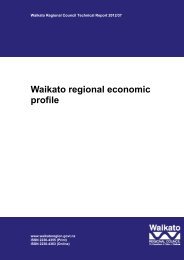Spatial distribution and seasonal variation in Undaria pinnatifida ...
Spatial distribution and seasonal variation in Undaria pinnatifida ...
Spatial distribution and seasonal variation in Undaria pinnatifida ...
Create successful ePaper yourself
Turn your PDF publications into a flip-book with our unique Google optimized e-Paper software.
high levels of predation <strong>and</strong> competition <strong>in</strong> these areas. While relatively low densities of grazers such as sea urch<strong>in</strong>s wereobserved on the adjacent reefs, most of the reefs adjacent to farms were dom<strong>in</strong>ated by dense macroalgal st<strong>and</strong>s ofEcklonia radiata, Carpophyllum maschalocarpum <strong>and</strong>/or C. flexuosum. Therefore it is likely that dense st<strong>and</strong>s of perennialmacroalgae adjacent to farms may play a role <strong>in</strong> prevent<strong>in</strong>g or slow<strong>in</strong>g the colonisation of <strong>Undaria</strong> at these sites. Thepresence of other kelp species (e.g. Ecklonia radiata) does however <strong>in</strong>dicate favourable conditions for <strong>Undaria</strong> growtharound these sites if it were to become established (Stuart <strong>and</strong> McClary, 2004).The short life span of <strong>Undaria</strong> spores results <strong>in</strong> a “step-wise” colonisation pattern (Gurois et al, 2011) as the short livedspores only travel 100m or so from the parent plants (Forrest et al, 2001). Drift<strong>in</strong>g plants <strong>and</strong>/or fragments that releasespores can be important modes of spread for seaweeds (Forrest et al, 2001). The harvest<strong>in</strong>g of mussels <strong>and</strong> otheroperational procedures on <strong>Undaria</strong> <strong>in</strong>fested mussel l<strong>in</strong>es would strip off such material <strong>and</strong> release it <strong>in</strong>to the surround<strong>in</strong>genvironment. The distance these plants or fragments travel depends on the water currents (Forrest et al, 2001; Torres etal, 2004: Verlaque, 2007). Given that <strong>Undaria</strong> does not have bladders, drift is not likely to facilitate the long distancespread of <strong>Undaria</strong> (Parsons, 1994). This limited ability to spread naturally via spore release (S<strong>in</strong>ner et al, 2000) or float<strong>in</strong>greproductive material (Parsons, 1994) results <strong>in</strong> what Russell et al (2007) refer to as a lag phase which lasts “a few years”be<strong>in</strong>g observed before <strong>Undaria</strong> <strong>in</strong>vades areas beyond its found<strong>in</strong>g population. Range expansion is also reliant on theappropriate substrate be<strong>in</strong>g available for colonisation. <strong>Undaria</strong> prefers primarily to colonise areas clear of other alga (Hay,1990), but has been seen to penetrate the kelp <strong>and</strong> fucoid zone, compet<strong>in</strong>g with native species after be<strong>in</strong>g established forlong enough to overcome the <strong>in</strong>itial lag phase (Russell et al, 2007). It should be noted that “Natural rates of dispersal are,however, likely to depend on local conditions, <strong>and</strong> may <strong>in</strong> any case be secondary importance to human-mediateddispersal” (Stuart 2004). Vessel hulls <strong>and</strong> aquaculture equipment are thought to be the ma<strong>in</strong> dispersal pathways (Hay,1990; Neill, 2008; Russell et al, 2008; S<strong>in</strong>ner et al, 2000; Verlaque, 2007). The macroscopic sporophytes as well as themicroscopic gametophyte stage can be spread by vessels of all sizes (S<strong>in</strong>ner et al, 2000) <strong>and</strong> the easily transportablemicroscopic phase is present at much greater levels over the summer when water temperatures are the highest,co<strong>in</strong>cid<strong>in</strong>g with the period of most recreational boat traffic (Thornber et al, 2004). Mar<strong>in</strong>e farm<strong>in</strong>g equipment <strong>and</strong> spat areknown to facilitate the transfer of <strong>Undaria</strong> from place to place (Perez et al, 1991; Stuart, 1997), as well as general fish<strong>in</strong>ggear such as ropes, anchors, crayfish pots, nets <strong>and</strong> div<strong>in</strong>g gear (S<strong>in</strong>ner et al, 2000).Although the surveys carried out were extensive, proof of absence of <strong>Undaria</strong> <strong>in</strong> coastal areas adjacent to mussel farmsites is difficult to assert when <strong>distribution</strong> could be discont<strong>in</strong>uous <strong>and</strong> surveys were not all <strong>in</strong>clusive. Some of the coastalsurveys were carried out <strong>in</strong> late summer when <strong>Undaria</strong> is typically at its lowest abundance (see below). Nevertheless,based on our monitor<strong>in</strong>g data <strong>and</strong> observations at Kirita we would still have expected to see low numbers of plants oraged sporophylls at coastal sites dur<strong>in</strong>g the summer months. The benthic habitat surround<strong>in</strong>g the boat ramps surveyed atPort Charles, Te Kouma, Waikawau <strong>and</strong> at Takawhare Bay was similar to that of coastal sites where <strong>Undaria</strong> was foundadjacent to mussel farms. The absence of <strong>Undaria</strong> at these popular recreational boat<strong>in</strong>g sites <strong>and</strong> the sw<strong>in</strong>g moor<strong>in</strong>gs atTakawhare Bay <strong>in</strong>dicates that the spread of <strong>Undaria</strong> around the Corom<strong>and</strong>el may not be closely associated withrecreational nautical activities.No <strong>Undaria</strong> plants were sighted on the mussel barge hulls at W<strong>in</strong>dy Po<strong>in</strong>t/Puhi Rare, but presence <strong>and</strong> transport of the<strong>Undaria</strong> gametophytes via barge hulls is highly likely. The absence of <strong>Undaria</strong> plants at the mussel barge moor<strong>in</strong>g sitecould possibly be due to the unsuitable nature of the habitat found there. This site is an <strong>in</strong>ner Harbour site with highturbidity, Secchi depth 2.7m. Another reason for the absence of <strong>Undaria</strong> may be the frequent use of the barges notallow<strong>in</strong>g for the growth of visible <strong>Undaria</strong> plants.Mussel farm sites are <strong>in</strong>herently areas with good water flow <strong>and</strong> sufficient nutrients to provide for the rapid growth <strong>and</strong>health of mussels for commercial harvest<strong>in</strong>g. The provision of artificial substrates such as l<strong>in</strong>es <strong>and</strong> floats <strong>in</strong> the highlyillum<strong>in</strong>ated shallow water (
















